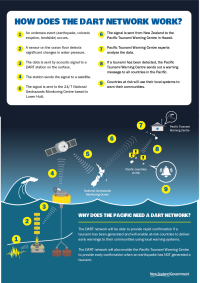Tsunami monitoring and detection network
Learn about New Zealand’s tsunami monitoring and detection network.
In 2019, the New Zealand Government deployed a Deep-ocean Assessment and Reporting of Tsunami (DART) buoys. This DART network improved New Zealand’s ability to monitor, detect and issue warnings about tsunami.
New Zealand’s entire coastline and some of our larger lakes are at risk of tsunami. This is because of our location in the Pacific and our geography. The biggest tsunami in New Zealand can arrive in less than an hour.
The DART network includes many DART stations. These let us know quickly if there is a tsunami. They let us give quicker and more accurate tsunami warnings through systems like Emergency Mobile Alerts.
What is a DART station?
DART stations are deep-ocean instruments that track changes in sea level. They are currently the only accurate way to quickly confirm if there is a tsunami before it reaches land.
DART stations are most important for earthquakes we can’t feel ourselves. In New Zealand, these often come from the Kermadec trench or further away.
How does the DART network work?
The DART network detects tsunami by measuring associated changes in water pressure using sea floor sensors. They are capable of measuring sea-level changes of less than a millimetre in the deep ocean. The DART network talks to a 24/7 monitoring centre in Wellington so that the 24/7 centre can assess the threat and warn the public.
DART network process – from seafloor to tsunami warning
 An event that could trigger a tsunami such as a large undersea earthquake or undersea volcanic eruption occurs.
An event that could trigger a tsunami such as a large undersea earthquake or undersea volcanic eruption occurs.- If there is a tsunami, the DART network’s sea floor sensors detect unusual water pressure changes.
- The DART stations sends the measurements by acoustic signal from the sea floor to the surface.
- The DART station sends the signal to a satellite.
- The signal is sent to the 24/7 National Geohazards Monitoring Centre (NGMC) at GNS Science.
- GNS Science Geohazards Analysts analyse the data.
- If a tsunami has been detected the NGMC will tell the National Emergency Management Agency (NEMA). NEMA is the official tsunami warning agency for New Zealand.
- NEMA will issue a tsunami warning to CDEM Groups, emergency services, media and the public.
- If the NGMC expects the tsunami to flood land areas, NEMA will also send an Emergency Mobile Alert.
Download the 'How does the DART network work' infographic (.pdf 450kb)
Get tsunami ready: Know the natural warning signs and take action
For a local source tsunami, which could arrive in minutes, there won’t be time for an official warning. It is important to recognise the natural warning signs and act quickly.
If you are near a shore and experience any of the following, take action. Do not wait for official warnings.
- Feel a strong earthquake that makes it hard to stand or a long earthquake that lasts more than a minute.
- See a sudden rise or fall in sea level.
- Hear loud or unusual noises from the sea.
Drop, Cover and Hold during the shaking. Protect yourself from the earthquake first.
As soon as the shaking stops, move immediately to the nearest high ground, out of all tsunami evacuation zones, or as far inland as you can.
Remember: If an earthquake is Long or Strong, Get Gone.
Find out what to do before, during and after a tsunami and how you can get ready at www.getready.govt.nz.
